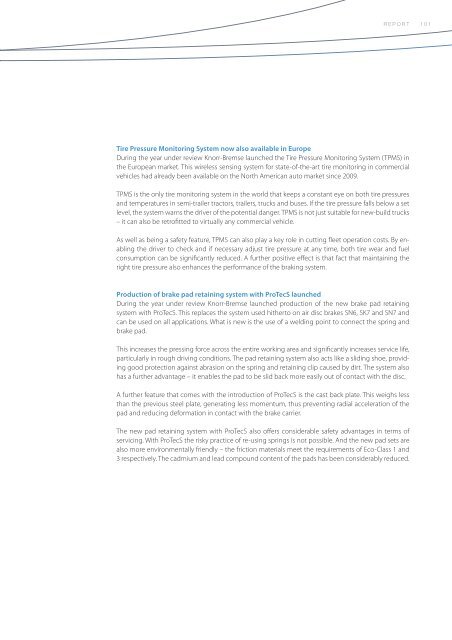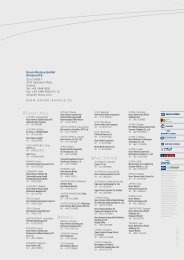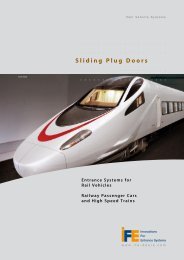Annual Report 2010 - Knorr-Bremse AG.
Annual Report 2010 - Knorr-Bremse AG.
Annual Report 2010 - Knorr-Bremse AG.
You also want an ePaper? Increase the reach of your titles
YUMPU automatically turns print PDFs into web optimized ePapers that Google loves.
RepoR t<br />
101<br />
Tire Pressure Monitoring System now also available in Europe<br />
During the year under review <strong>Knorr</strong>-<strong>Bremse</strong> launched the Tire Pressure Monitoring System (TPMS) in<br />
the European market. This wireless sensing system for state-of-the-art tire monitoring in commercial<br />
vehicles had already been available on the North American auto market since 2009.<br />
TPMS is the only tire monitoring system in the world that keeps a constant eye on both tire pressures<br />
and temperatures in semi-trailer tractors, trailers, trucks and buses. If the tire pressure falls below a set<br />
level, the system warns the driver of the potential danger. TPMS is not just suitable for new-build trucks<br />
– it can also be retrofitted to virtually any commercial vehicle.<br />
As well as being a safety feature, TPMS can also play a key role in cutting fleet operation costs. By enabling<br />
the driver to check and if necessary adjust tire pressure at any time, both tire wear and fuel<br />
consumption can be significantly reduced. A further positive effect is that fact that maintaining the<br />
right tire pressure also enhances the performance of the braking system.<br />
Production of brake pad retaining system with ProTecS launched<br />
During the year under review <strong>Knorr</strong>-<strong>Bremse</strong> launched production of the new brake pad retaining<br />
system with ProTecS. This replaces the system used hitherto on air disc brakes SN6, SK7 and SN7 and<br />
can be used on all applications. What is new is the use of a welding point to connect the spring and<br />
brake pad.<br />
This increases the pressing force across the entire working area and significantly increases service life,<br />
particularly in rough driving conditions. The pad retaining system also acts like a sliding shoe, providing<br />
good protection against abrasion on the spring and retaining clip caused by dirt. The system also<br />
has a further advantage – it enables the pad to be slid back more easily out of contact with the disc.<br />
A further feature that comes with the introduction of ProTecS is the cast back plate. This weighs less<br />
than the previous steel plate, generating less momentum, thus preventing radial acceleration of the<br />
pad and reducing deformation in contact with the brake carrier.<br />
The new pad retaining system with ProTecS also offers considerable safety advantages in terms of<br />
servicing. With ProTecS the risky practice of re-using springs is not possible. And the new pad sets are<br />
also more environmentally friendly – the friction materials meet the requirements of Eco-Class 1 and<br />
3 respectively. The cadmium and lead compound content of the pads has been considerably reduced.








![Geschäftsbericht 2012 [PDF, 13 MB] - Zelisko](https://img.yumpu.com/22524926/1/184x260/geschaftsbericht-2012-pdf-13-mb-zelisko.jpg?quality=85)







